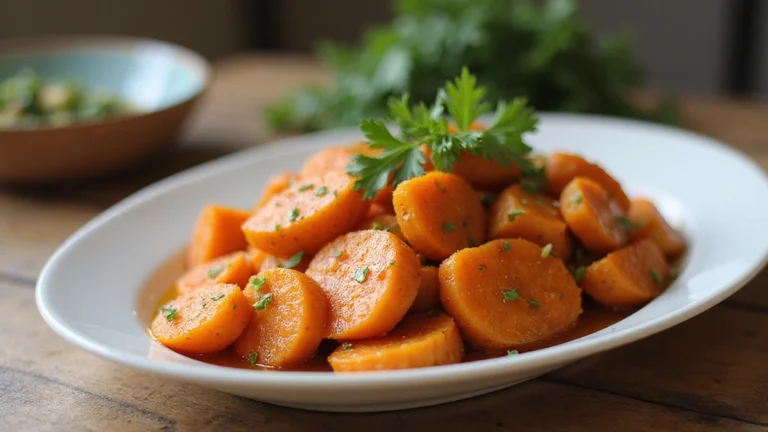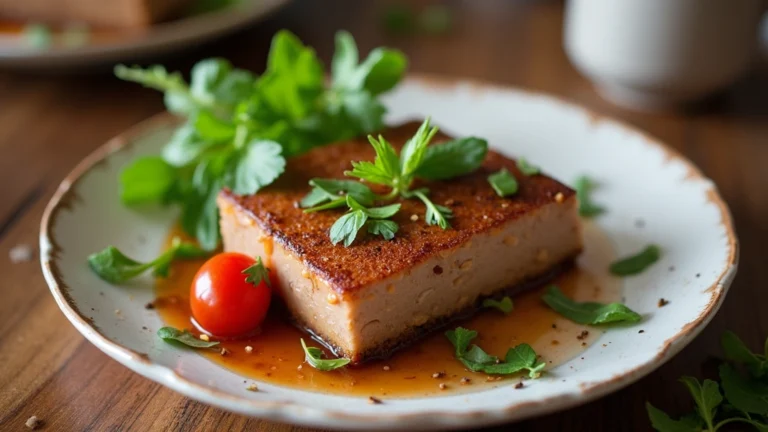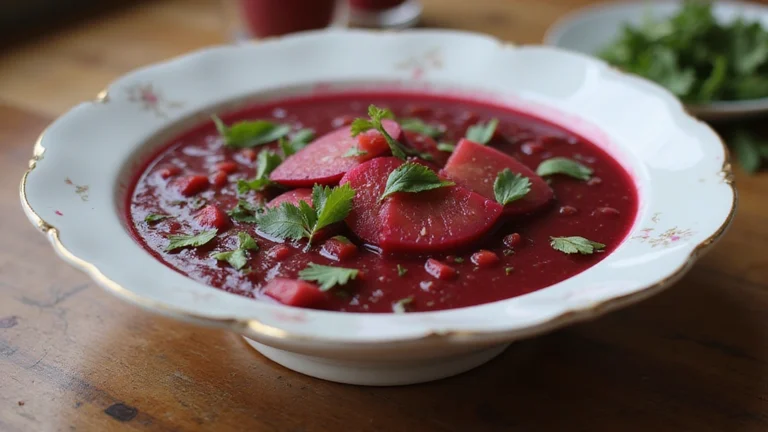
Have you ever tried sirinica, the delicious Eastern European pastry that’s taking breakfast tables by storm? This savory treat combines layers of soft dough with tangy cheese for a comfort food experience you won’t forget.
Sirinica is a beloved traditional dish popular throughout the Balkans, especially in countries like Serbia, Croatia, and Bosnia. It’s similar to burek but typically features a simpler preparation with a distinctive layering technique that creates a perfect balance of crispy exterior and soft, cheese-filled interior.
You’ll love how this versatile dish works for breakfast, brunch, or even as a satisfying snack. While traditionally made with white cheese similar to feta, modern variations might include cottage cheese or farmer’s cheese for a milder flavor profile. The beauty of sirinica lies in its simplicity—humble ingredients transformed into something truly memorable.
What Is Sirinica?
Sirinica is a traditional Balkan pastry characterized by its layers of soft dough filled with creamy cheese. This savory treat features a distinctive texture that’s simultaneously crisp on the outside and tender within. The name “sirinica” derives from the Slavic word “sir” meaning cheese which perfectly describes its primary filling ingredient.
Unlike its cousin burek which often contains meat or vegetables sirinica exclusively showcases cheese as its star component. The pastry consists of multiple thin layers of dough (similar to phyllo but slightly thicker) alternating with generous amounts of cheese mixture. When baked this combination creates a harmonious blend of flavors and textures that has made it a staple in Eastern European cuisine.
Traditional sirinica uses white cheese similar to feta though regional variations exist throughout the Balkans. In Serbia it’s typically made with a local cheese called “sir” while Croatian and Bosnian versions might incorporate different local dairy products. The cheese filling is usually enhanced with eggs and sometimes sour cream which adds richness and helps bind the layers together.
What truly sets sirinica apart is its preparation method. The dough is stretched extremely thin then folded multiple times with cheese between layers creating a pastry that puffs dramatically during baking. This technique results in the characteristic flaky exterior that contrasts beautifully with the creamy interior. While similar to other layered pastries like börek or banitsa sirinica maintains its unique identity through exact proportions of cheese to dough and particular folding techniques.
Sirinica holds important cultural importance across the Balkans where it appears at family gatherings celebrations and everyday meals alike. The pastry represents the region’s rich culinary heritage and demonstrates how simple ingredients can transform into something truly special through traditional techniques passed down through generations.
History And Cultural Significance Of Sirinica
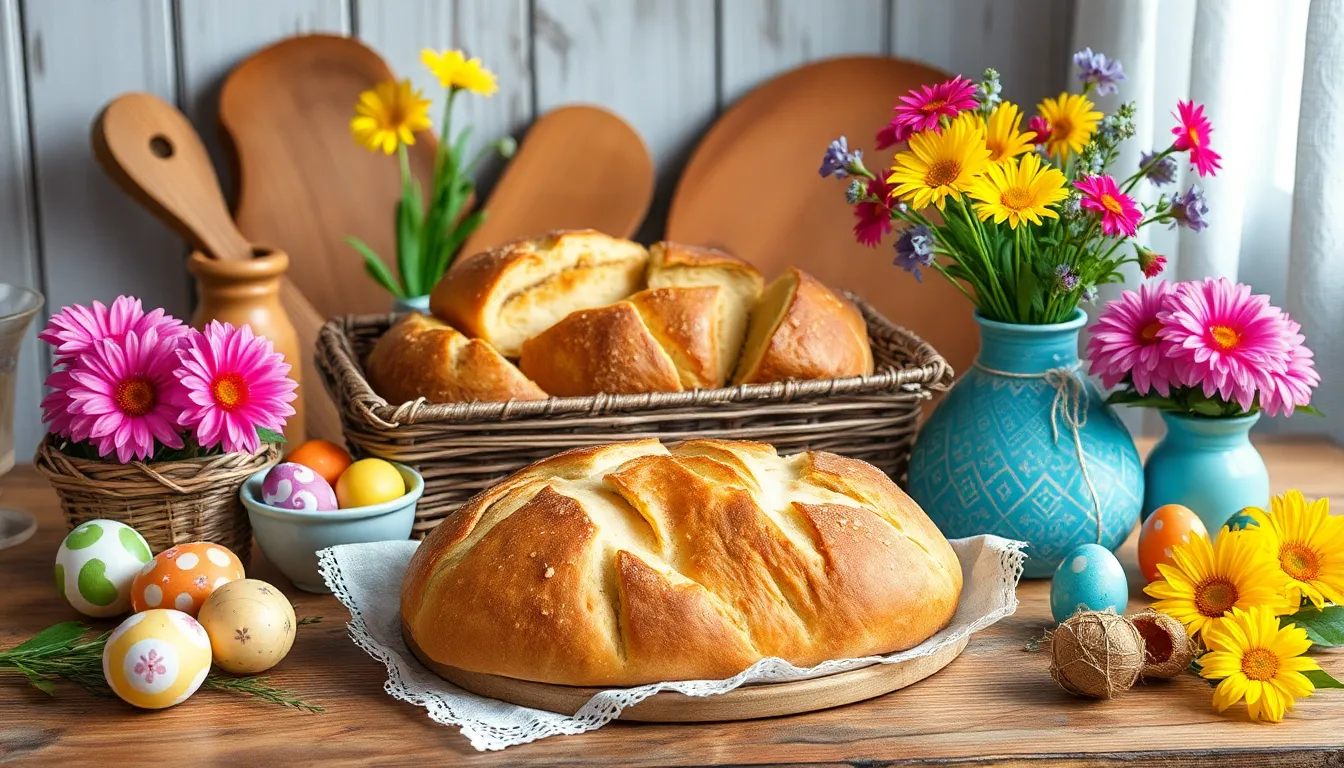
Sirinica boasts a rich heritage that extends back centuries within Croatian culinary tradition. This beloved sweet bread, also known as Pinca or Sirnica, originated from ancient Christian customs surrounding Easter celebrations. Etymologically the name “pinca” likely derives from the Italian word “panetto” meaning a small bread loaf, highlighting the cultural exchanges between Croatia and neighboring Mediterranean regions.
Easter symbolizes renewal and joy throughout Croatia where Sirinica plays a central role in festivities. This special bread represents much more than mere sustenance—it marks the end of Lent and celebrates Christ’s resurrection in Christian households. Families gather across generations to prepare this traditional treat, with the kneading and baking process serving as an important bonding ritual that preserves ancestral recipes.
The preparation of Sirinica embodies the spirit of togetherness that defines Croatian Easter celebrations. Each family typically maintains their unique version of the recipe, passed down through generations with minor variations that reflect regional influences. The fragrant sweet flavor profile and distinctive preparation techniques make Sirinica an essential component of Easter tables throughout the country.
Regional variations exist beyond Croatia’s borders, with similar breads appearing in Italy and Slovenia where they might be called pinza or pogača. But Sirinica holds a special place in Croatian cultural identity and is recognized as an intangible cultural tradition specifically connected to Easter observances. The bread’s significance transcends its ingredients, representing cultural pride and continuity of tradition.
In Croatian homes, sharing Sirinica among family members and friends symbolizes unity and communal celebration. The bread connects modern Croatians to their ancestors through the preservation of traditional baking methods and flavor profiles. This sweet bread stands as a delicious testament to Croatia’s rich cultural heritage, linking contemporary celebrations to centuries-old practices.
Equipment Needed

Preparing traditional sirinica requires exact kitchen tools to achieve those perfect layers of dough and cheese. Gathering your equipment before starting will make the process smoother and more enjoyable.
Essential Baking Tools
To create authentic sirinica you’ll need:
- Large mixing bowl for preparing the dough
- Medium bowl for cheese filling preparation
- Measuring cups and spoons for accurate ingredients
- Rolling pin for initial dough shaping
- Clean cotton kitchen towel or tablecloth for stretching dough
- Rectangular baking pan (approximately 9×13 inches)
- Pastry brush for applying butter or oil
- Sharp knife for cutting portions
- Spatula for serving
Specialized Equipment
For the most traditional preparation method you should have:
- Wooden working surface or large table for dough stretching
- Specialized dough roller (oklava) if available
- Parchment paper for lining the baking pan
- Kitchen thermometer to ensure proper oven temperature
- Timer to track baking progress
Modern Alternatives
Many home cooks successfully prepare sirinica with these contemporary options:
- Stand mixer with dough hook attachment for easier dough preparation
- Food processor for quickly blending cheese filling
- Silicone baking mat as an alternative surface for stretching dough
- Non-stick cooking spray instead of traditional butter or lard
- Kitchen scale for precise measurements
Having all equipment ready before beginning will ensure your sirinica preparation flows seamlessly from mixing to stretching to baking. Each tool serves a exact purpose in creating those characteristic flaky layers and creamy cheese filling that define this beloved Balkan pastry.
Ingredients For Sirinica
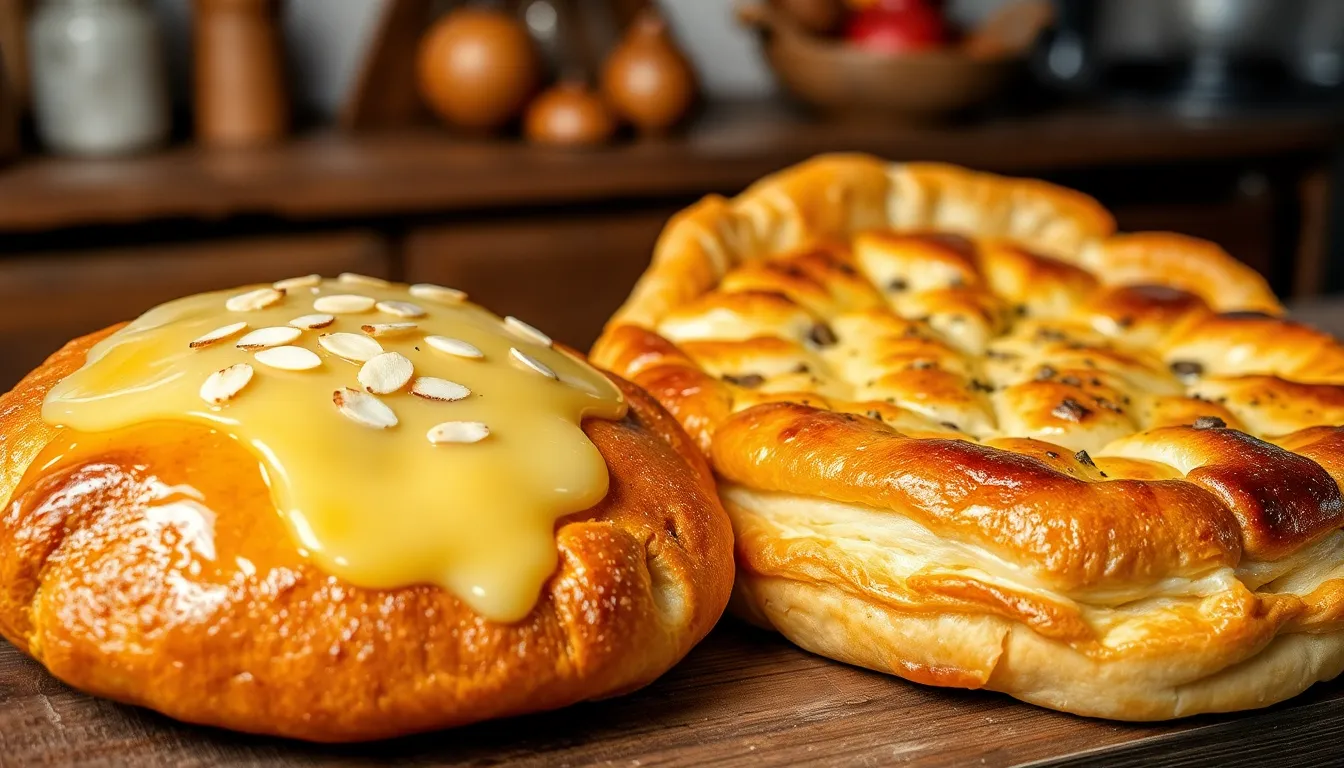
Sirinica exists in two distinct traditional variations from the Balkan region: a sweet Easter bread popular in Croatia and a savory cheese pie beloved throughout Bosnia. Both versions require exact ingredients to achieve their authentic flavors and textures.
Dough Ingredients
For the sweet Croatian Easter bread (Sirnica/Pinca), you’ll need:
- 500g to 1kg all-purpose flour
- 8g to 40g active or instant dry yeast
- 60g to 200g white granulated sugar
- 10g bourbon vanilla sugar or vanilla sugar
- A pinch to ½ teaspoon salt
- 50g to 200g unsalted butter
- 50g lard (optional)
- Eggs (2 whole eggs plus 3 egg yolks, or 6 egg yolks)
- 100ml to 500ml warm milk
- 1-1.5 tablespoons rum
- A shot of rakija (fruit brandy, optional)
- 1 teaspoon freshly grated lemon zest
- 1 teaspoon freshly grated orange zest
- 1 egg yolk for brushing before baking
- Almond flakes or pearl sugar for topping
For the savory Bosnian cheese pie (Pita Sirnica), you’ll need approximately 500g of phyllo dough sheets. Some recipes include a homemade dough preparation using sparkling water (about 500ml) and vegetable oil (100ml).
Filling Ingredients
The sweet Croatian Easter bread doesn’t have a separate filling as the flavors come from the enriched dough itself with citrus zests and alcohol.
For the savory Bosnian cheese pie, gather these filling ingredients:
- 250g cottage cheese
- 180g feta cheese
- 3-4 tablespoons sour cream
- 1-2 eggs (or more depending on your preferred recipe)
- Salt to taste
- Oil for greasing the baking dish and sometimes incorporated in the dough mixture
The combination of cottage cheese and feta creates the distinctive tangy flavor profile traditional to authentic sirnica, while the eggs and sour cream add richness and bind the filling together.
How To Make Sirinica

Mastering sirinica requires attention to detail whether you’re creating the savory Bosnian cheese pie or the sweet Croatian Easter bread. Both versions showcase distinct preparation methods that highlight the versatility of this beloved Balkan dish.
Preparing The Dough
For Bosnian cheese pie (pita sirnica), you’ll need phyllo dough sheets that should be thawed completely and brought to room temperature before use. Keep the phyllo sheets covered with plastic wrap and a damp towel while working to prevent them from drying out and cracking. If making homemade phyllo, ensure your dough is stretched extremely thin for authentic texture.
For Croatian Easter bread (sirnica), start by warming 100 ml of milk to lukewarm temperature. Mix this warm milk with yeast, a teaspoon of sugar, and a small amount of flour to create a starter, then let it rise for 15 minutes until foamy. Combine this starter with 1 kg of all-purpose flour, 200 g melted butter, 200 g sugar, vanilla sugar, 6 egg yolks, and 400 ml of remaining milk in a large bowl. Add citrus zests from lemon and orange plus a splash of rum and fruit brandy (rakija) for traditional flavor. Knead thoroughly until smooth and elastic, then cover and allow to rise for 8-10 hours or overnight for proper fermentation.
Making The Filling
For the Bosnian savory version, beat 3 eggs in a large bowl until well combined. Fold in the cheeses—cottage cheese (small curd), crumbled feta, and shredded mozzarella—mixing gently until fully incorporated. Add a dollop of sour cream for extra creaminess if desired. Season the mixture with salt to taste, being mindful that feta already contributes saltiness to the filling.
The Croatian sweet version doesn’t require a separate filling as the enriched dough itself contains all the flavorful ingredients. Your dough becomes the star with its complex flavors from citrus zests, rum, and fruit brandy incorporated directly into the mixture.
Assembling The Sirinica
For Bosnian cheese pie, preheat your oven to 400°F (200°C) and lightly butter a 9×13 baking pan. Layer several sheets of phyllo in the pan, brushing each with melted butter or oil to create a crisp foundation. Spread the cheese mixture evenly across the layered phyllo base. Continue layering additional phyllo sheets on top, brushing each with butter to ensure golden, flaky layers.
For Croatian Easter bread, after the long rise period, turn the dough onto a floured surface and divide it into three equal portions. Shape each portion into a ball and place them on a baking sheet with enough space between them to allow for expansion. Let these dough balls rise again until noticeably puffy. Brush the tops with beaten egg yolk and sprinkle with crushed sugar for a sweet finish. Make three deep cuts from the center outward in each ball, creating the traditional pattern.
Baking Instructions
Bake the Bosnian cheese pie at 400°F (200°C) for approximately 30-40 minutes until the top turns golden brown and crispy. You’ll know it’s done when the edges pull away slightly from the pan and the filling is set. Allow the pie to cool for 10-15 minutes before slicing to let the filling set properly. This savory version can be enjoyed hot or cold and remains fresh in the refrigerator for up to two days.
The Croatian Easter bread requires baking at 200°C (400°F) for about 30 minutes. Watch for the bread to achieve a rich golden color while maintaining a soft interior. The sugar topping should caramelize slightly without burning. Test for doneness by tapping the bottom of the bread—a hollow sound indicates it’s perfectly baked. Allow the bread to cool completely on a wire rack before slicing to preserve its texture and intricate flavors.
Serving Suggestions

Traditional sirnica deserves to be showcased with complementary accompaniments that enhance its rich cheese flavors and flaky texture. Serve this Bosnian cheese pie hot or warm to fully appreciate its comforting qualities and crispy exterior.
Yogurt or kefir makes an excellent pairing with savory sirnica, creating a balanced combination that cuts through the richness of the cheese filling. The tanginess of these dairy beverages provides a refreshing contrast to the savory pie.
Family-style presentation works best for sirnica – place the entire pie in the center of the table and cut it into square or triangular portions just before serving. This communal serving method honors the traditional Balkan approach to sharing meals.
For a complete breakfast or brunch spread, accompany sirnica with fresh seasonal fruits and a selection of cured meats. This combination transforms the cheese pie from a simple snack into a satisfying meal suitable for weekend gatherings.
Consider serving the Croatian sweet version (Easter bread sirnica) with coffee or tea during morning celebrations. Its subtle sweetness pairs wonderfully with these beverages and creates a festive atmosphere perfect for holiday gatherings.
Sprinkle a light dusting of powdered sugar over sweet sirnica slices for an elegant presentation. This simple finishing touch elevates the appearance and adds a touch of extra sweetness that complements the citrus notes in the bread.
Store any leftover sirnica properly by covering it with a clean kitchen towel or plastic wrap once completely cooled. While best enjoyed fresh, the savory version can be reheated in a 350°F oven for 5-10 minutes to restore its crispy exterior.
Storage Tips
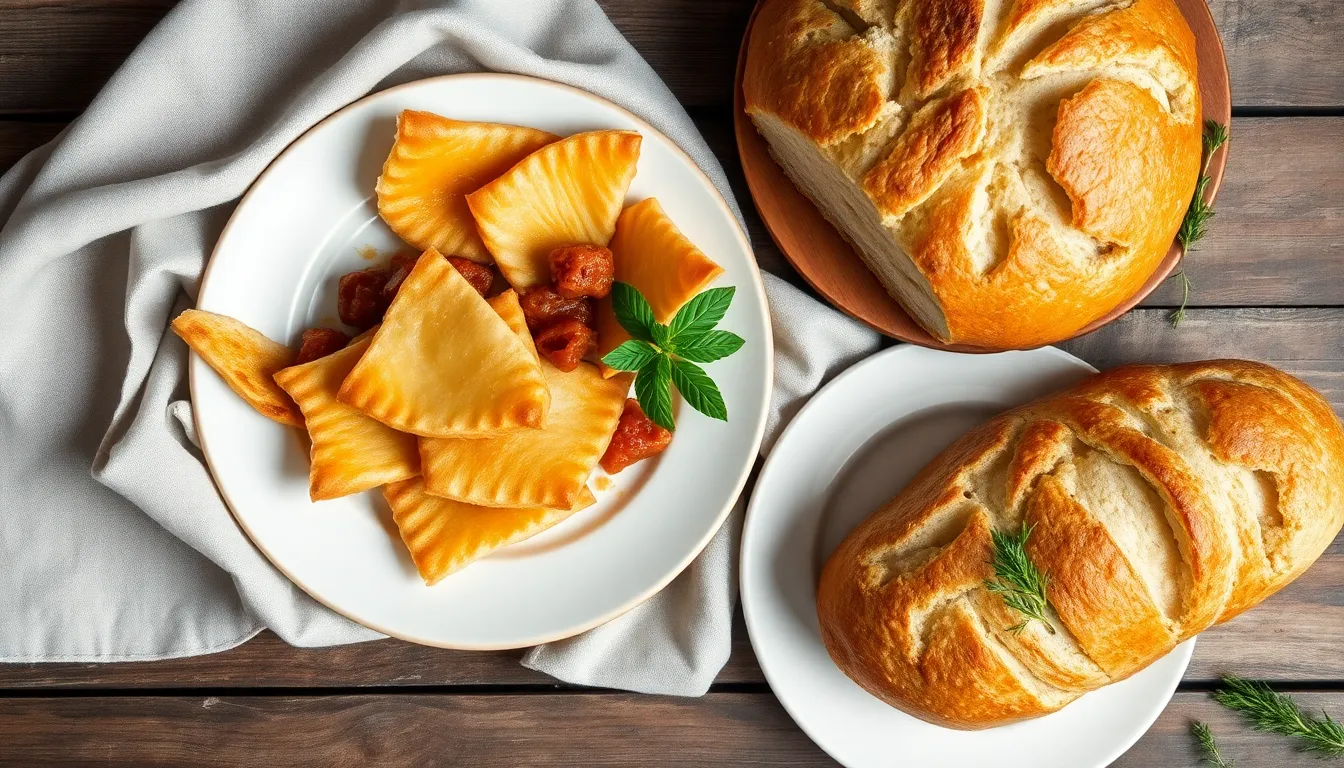
Preserving your sirinica properly ensures you can enjoy this Balkan delicacy for several days after preparation. Both the savory Bosnian cheese pie and sweet Croatian Easter bread versions require exact storage methods to maintain their distinctive textures and flavors.
For the savory Bosnian sirinica, allow it to cool completely before storing. Transfer leftover pieces to airtight containers or wrap tightly with aluminum foil to prevent the phyllo layers from drying out. Refrigerate for up to 3-4 days for optimal freshness.
The sweet Croatian Easter bread (Pinca/Sirnica) stays fresh longer due to its enriched dough. Store it in a bread box or paper bag at room temperature for 2-3 days to maintain its soft texture. For extended storage, wrap individual portions in plastic wrap and place them in a freezer-safe container.
Freezing works well for both varieties. Cut the savory sirinica into portion-sized pieces before freezing to make reheating easier. Place parchment paper between layers to prevent sticking. The sweet version can be frozen whole or in slices, tightly wrapped in plastic wrap and aluminum foil.
Transfer pantry items used for sirinica preparation into transparent containers for easy identification. This organization method helps track inventory and ensures ingredients remain fresh for your next baking session.
When reheating the savory sirinica, use an oven preheated to 350°F (175°C) for about 10-15 minutes to restore the crispy exterior. Avoid microwave reheating as it makes the phyllo dough soggy and compromises the texture. The sweet version tastes delicious at room temperature but can be gently warmed in the oven at 300°F (150°C) for 5 minutes if desired.
Use stackable containers for efficient refrigerator organization when storing multiple batches of sirinica. Label containers with preparation dates to ensure you consume them within the recommended timeframe.
Variations Of Traditional Sirinica
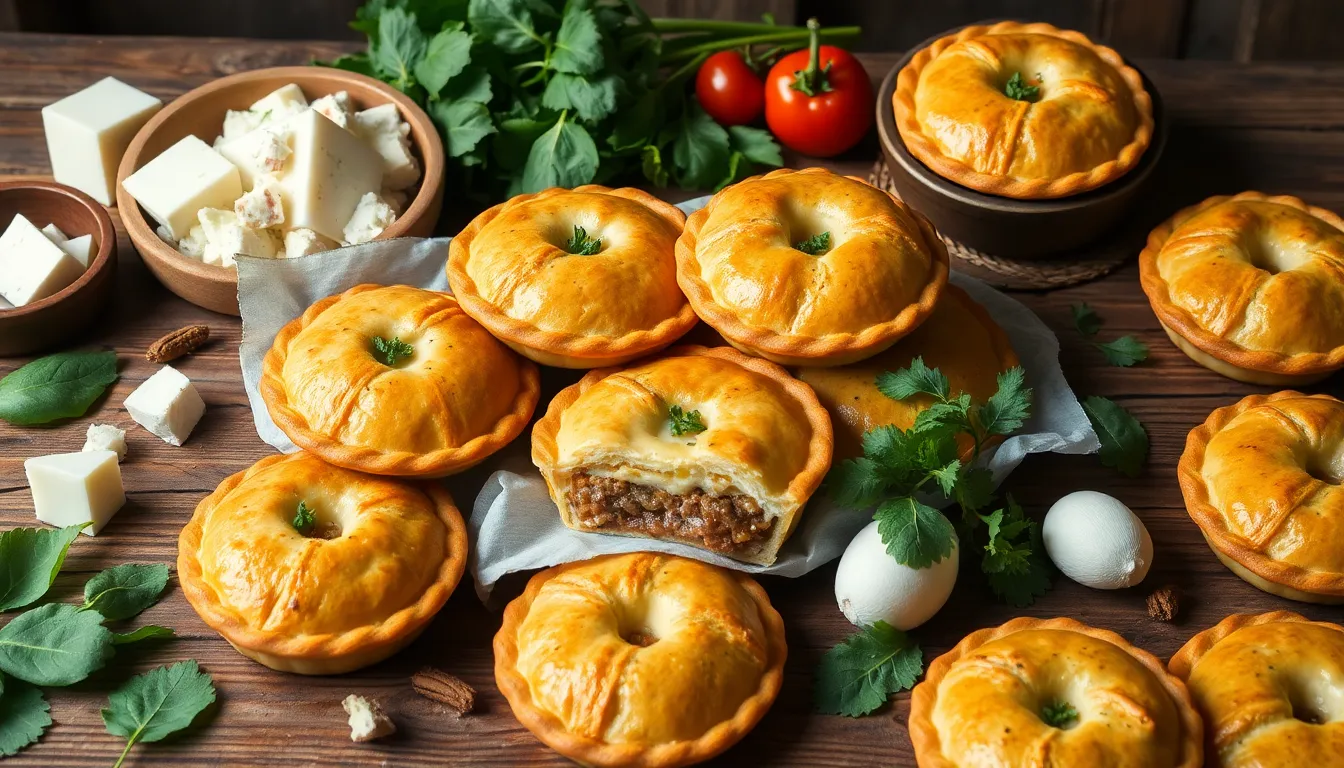
Sirinica showcases remarkable diversity across Balkan regions with two primary styles – the savory Bosnian cheese pie and the sweet Croatian Easter bread. Each version boasts its own unique preparation methods textures and cultural significance.
Cheese Variations
The classic Bosnian pita sirnica features a sumptuous cheese filling that forms the heart of this beloved dish. Traditional recipes use local white cheeses similar to feta rather than ricotta offering a tangier flavor profile. You can create an authentic filling by combining these cheeses with eggs and a generous dollop of sour cream for enhanced creaminess. Regional variations exist throughout the Balkans with some areas preferring a drier crumblier cheese while others opt for a more luxurious blend. The cheese mixture gets layered between sheets of thin filo dough resulting in the characteristic flaky exterior that contrasts beautifully with the rich filling. For a modern twist many home cooks now incorporate varieties like farmer’s cheese or even goat cheese to introduce subtle flavor nuances while maintaining the traditional texture.
Meat Variations
While traditional sirnica emphasizes cheese as its star ingredient related Balkan pies include delicious meat-filled alternatives. Burek stands as the most popular meat variation featuring seasoned ground beef or lamb mixed with sautéed onions and distinctive spices. You can prepare this hearty version using the same filo dough technique but substitute the cheese filling with the savory meat mixture. Some regional recipes combine both cheese and meat creating a satisfying hybrid that offers the best of both worlds. Northern Balkan communities sometimes include additional ingredients like mushrooms or peppers to complement the meat filling. These meat variations typically require longer baking time to ensure the filling cooks thoroughly while maintaining the characteristic crispy exterior that makes these pastries so appealing.
Vegetarian Options
Beyond the classic cheese sirnica many vegetable-based variations expand the repertoire of these traditional pies. Zeljanica (zeljanik) represents a popular alternative featuring spinach mixed with the cheese base creating a nutritious and flavorful filling. Potato lovers gravitate toward krumpiruša which combines mashed potatoes with subtle seasonings between the delicate dough layers. You can also find seasonal variations incorporating pumpkin or zucchini particularly during harvest months when these vegetables are at their peak freshness. The preparation method remains consistent across these vegetarian options with the filling sandwiched between thin layers of stretched dough and baked until golden. These plant-forward variations maintain the comforting appeal of traditional sirnica while offering lighter alternatives that showcase the agricultural bounty of the Balkan region.
Nutritional Information

Understanding the nutritional profile of sirinica can help you make informed dietary choices while enjoying this traditional Balkan delicacy. Whether you’re tracking your macronutrients or simply curious about what you’re consuming, here’s a comprehensive breakdown of what sirinica offers nutritionally.
A typical serving of Bosnian cheese pie (sirinica) provides approximately 242-327 calories, making it a moderately caloric option that can fit into a balanced meal plan. The protein content ranges from 10.8 to 15 grams per serving, primarily derived from the cheese components that form the heart of this dish.
The fat content in sirinica is substantial, with 13-24.7 grams per serving, including 6-10 grams of saturated fat. This reflects the generous use of cheese and possibly butter or oil in the preparation process. Cholesterol levels measure between 69.8-77 mg per serving.
Carbohydrate content remains relatively moderate at 15.7-16 grams per serving, with minimal sugar (0.2-3 grams) and dietary fiber (0.5-1 gram). The sodium content is notable at 493.7-743 mg per serving, which aligns with the salty nature of the cheeses traditionally used.
| Nutrient | Amount per Serving |
|---|---|
| Calories | 242-327.5 kcal |
| Total Fat | 13-24.7 g |
| Saturated Fat | 6-10 g |
| Cholesterol | 69.8-77 mg |
| Sodium | 493.7-743 mg |
| Total Carbohydrates | 15.7-16 g |
| Dietary Fiber | 0.5-1 g |
| Sugars | 0.2-3 g |
| Protein | 10.8-15 g |
| Potassium | 68.4-149 mg |
Sirinica offers impressive amounts of essential vitamins and minerals. The calcium content stands out at 17-25.6% of daily value per serving, supporting bone health thanks to the cheese-based filling. Iron contributes 6-6.5% of your daily needs, while vitamin B-12 provides 11.4%.
The dish contains important amounts of riboflavin (24.4%) and selenium (22.6%), along with phosphorus (20.4%) and zinc (10.1%). These nutrients support various metabolic functions including energy production and immune system health.
| Vitamin/Mineral | % Daily Value per Serving |
|---|---|
| Calcium | 17-25.6% |
| Riboflavin | 24.4% |
| Selenium | 22.6% |
| Phosphorus | 20.4% |
| Vitamin B-12 | 11.4% |
| Zinc | 10.1% |
| Folate | 8.1% |
| Vitamin B-6 | 7.3% |
| Vitamin A | ~7% |
| Iron | 6-6.5% |
| Magnesium | 3.9% |
| Vitamin C | 0.1-1% |
The nutritional profile varies based on exact ingredients used in your sirinica recipe. Traditional recipes using feta and mild cheddar cheese contribute significantly to the protein and fat content, while phyllo dough accounts for most carbohydrates. Adding spinach or other vegetables can boost the fiber and vitamin content beyond these base values.
For those monitoring their sodium intake, consider using lower-sodium cheese alternatives or reducing the amount of added salt in your recipe. The rich calcium content makes sirinica a beneficial option for those focused on bone health, though its moderate to high fat content suggests enjoying it in balanced portions.
Perfect Pairings With Sirinica

Sirinica wine offers a versatile profile that complements many dishes creating memorable dining experiences. The ruby red wine with violet hints pairs excellently with traditional Italian cuisine and regional specialties.
First Course Pairings
- Pasta dishes featuring robust vegetable sauces
- Hearty meat-based sauces like authentic Neapolitan ragu
- Traditional Bolognese with its rich tomato and meat components
- Risotto with mushrooms or wild game
Main Course Selections
- Grilled red meats that highlight the wine’s soft tannins
- Game dishes such as venison or wild boar
- Slow-roasted lamb with herbs
- Braised beef dishes that match the wine’s structure
Cheese Companions
- Aged cheeses with pronounced flavors
- Semi-hard regional Italian varieties
- Pecorino in various aging stages
- Parmigiano-Reggiano with its crystalline texture
Serve Sirinica in a large wine glass at room temperature to fully experience its aromatic complexity. The wine’s fresh peppery notes reminiscent of northern Rhône Syrah make it particularly suitable for dishes with aromatic herbs and spices. Its juicy cherry-like fruit flavors and soft structure create a balanced accompaniment to foods without overpowering them.
For optimal enjoyment allow the wine to breathe for 30 minutes before serving. This approachable alternative to the more tannic Aglianico delivers a long finish with pleasant red fruit and spice notes that linger beautifully after each bite of your chosen pairing.
Conclusion
Sirinica stands as a testament to the Balkans’ rich culinary heritage with its versatile nature spanning from savory cheese pies to sweet Easter breads. Whether you’re enjoying the crispy-yet-soft Bosnian variation with yogurt or the sweet Croatian version with your morning coffee you’re participating in centuries-old traditions.
The beauty of sirinica lies in its adaptability. You can explore different cheese combinations customize fillings or adjust ingredients for dietary needs while still honoring its authentic roots.
As this Eastern European delicacy continues gaining popularity worldwide it offers not just nourishment but a connection to cultural celebrations and family gatherings. Try making sirinica at home and discover why this humble pastry has earned its place at tables across generations.
Frequently Asked Questions
What is sirinica?
Sirinica is a popular Eastern European pastry with layers of soft dough and tangy cheese. It originated in the Balkans, particularly in Serbia, Croatia, and Bosnia. The name comes from the Slavic word “sir” meaning cheese. It features a crisp exterior and a tender, creamy interior, making it a beloved comfort food throughout the region.
How is sirinica different from burek?
While both are layered pastries, sirinica exclusively features cheese filling, whereas burek often contains meat or vegetables. Sirinica also tends to have a simpler preparation process. Both dishes share similar preparation techniques using thin, stretched dough, but they serve different roles in Balkan cuisine, with sirinica being particularly associated with breakfast and special occasions.
What are the two main variations of sirinica?
There are two distinct traditional variations: the sweet Croatian Easter bread (also called Pinca or Sirnica) and the savory Bosnian cheese pie. The sweet version incorporates yeast, sugar, and citrus zests, while the savory pie uses phyllo dough sheets filled with a mixture of cottage cheese, feta cheese, sour cream, and eggs.
What equipment do I need to make sirinica?
Essential equipment includes a large mixing bowl, measuring cups, rolling pin, and rectangular baking pan. Traditional preparation benefits from a wooden working surface and specialized dough roller, though modern alternatives like a stand mixer can also be used. Having all equipment ready before starting ensures a smooth preparation process.
What cheese is traditionally used in sirinica?
Traditional sirinica uses white cheese similar to feta, which provides its characteristic tangy flavor. Regional variations may use local white cheeses specific to Balkan areas. Modern adaptations sometimes incorporate milder options like cottage cheese or farmer’s cheese, while some creative versions use goat cheese for a distinctive taste.
How should sirinica be served?
The savory Bosnian cheese pie is best served family-style, paired with yogurt or kefir. The sweet Croatian version pairs excellently with coffee or tea and can be enhanced with a dusting of powdered sugar. Both should be served warm for the best texture and flavor experience.
What is the nutritional profile of sirinica?
A typical serving of Bosnian cheese sirinica contains approximately 242-327 calories, with significant protein and fat from the cheese. It’s rich in calcium, riboflavin, and selenium, though it can be high in sodium. The nutritional content varies based on specific ingredients and preparation methods. Consider portion control if monitoring dietary intake.
How should sirinica be stored?
For savory sirinica, store leftovers in an airtight container in the refrigerator for up to 3 days. Reheat in an oven at 350°F (175°C) to maintain crispness. The sweet Croatian version can be kept at room temperature for 2-3 days if wrapped properly. Both versions can be frozen for longer storage, though texture may change slightly upon thawing.
What is sirinica wine?
Sirinica wine is a versatile beverage that pairs well with the pastry and other dishes. It complements pasta with robust sauces, grilled meats, game dishes, and aged cheeses. Serve it at room temperature in a large glass after allowing it to breathe for 30 minutes to enhance its aromatic complexity and flavors.
What cultural significance does sirinica have?
Sirinica holds deep cultural importance across the Balkans, particularly in Croatia where the sweet version is associated with Easter celebrations and symbolizes renewal and joy. It serves as a family bonding ritual, with each household typically maintaining their unique recipe variation. It’s recognized as an intangible cultural tradition in Croatia, representing the region’s rich culinary heritage.
